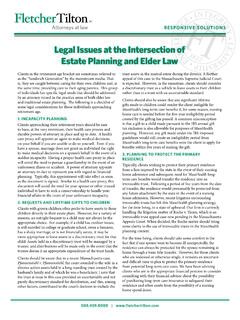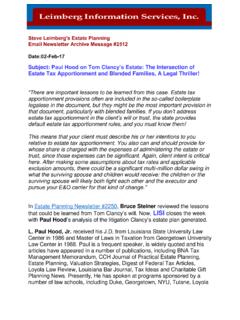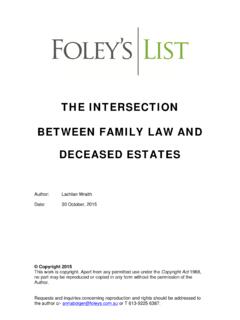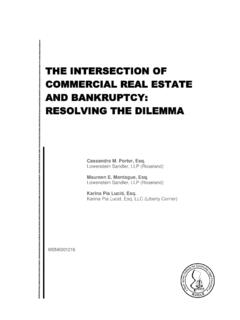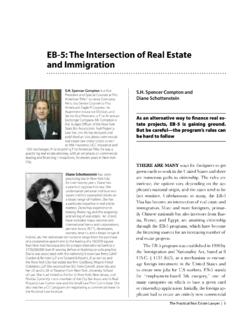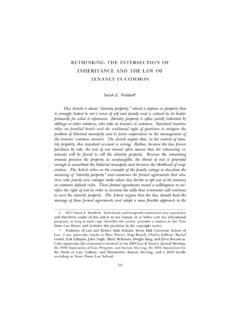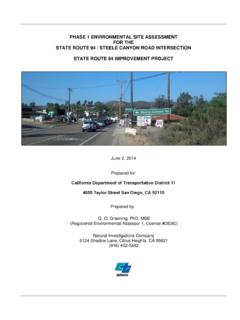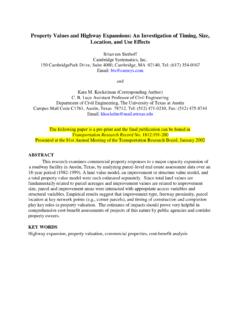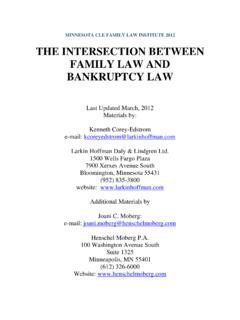Transcription of VENN DIAGRAMS: THE INTERSECTION OF ESTATE & …
1 IVENN diagrams : THE INTERSECTION OF ESTATE & INCOME TAX (PLANNING IN THE ATRA-MATH) Paul S. Lee, , National Managing Director Bernstein Global Wealth Management New York, NY (212) 756-4352 Email: September 1, 2014 TABLE OF CONTENTS I. INTRODUCTION A. The Old Paradigm: When In Doubt, Transfer Out B. The New Tax Landscape 1. Generally 2. Pertinent Provisions of ATRA a. Federal Transfer Tax Landscape b. Pertinent Income Tax Provisions 3. The Medicare Tax on Net Investment Income 4. Disparity among the States C. The New Paradigm in ESTATE Planning D. Portability and the New Paradigm II. TRANSFER TAX COST VS. INCOME TAX SAVINGS FROM THE STEP-UP A. Generally B. Transfer Tax Cost: State of Domicile, Spending, Time Horizon C. Community Property Considerations III. SECTION 1014 AND THE TAX NATURE OF CERTAIN ASSETS A. General Rule: The Step-Up in Basis to Fair Market Value B. Section 1014(e): The One Year Conundrum C. Community Property and Elective/Consensual Community Property D.
2 Establishing Community Property and Maintaining the Character E. The Joint Revocable Trust and the JEST F. Section 2038 Marital Trusts G. The Tax Nature of Particular Assets 1. Generally 2. Creator-Owned Intellectual Property, Intangible Assets, and Artwork a. Generally b. Copyrights c. Patents d. Artwork 3. Negative Basis and Negative Capital Account Partnership Interests 4. Traditional IRA and Qualified Retirement Assets 5. Passive Foreign Investment Company (PFIC) Shares 6. Qualified Small Business Stock (QSBS) iiIV. MAXIMIZING AND MUTIPLYING THE STEP-UP IN BASIS A. Generally B. Swapping Assets with Existing IDGTs C. Valuation Discounts On or Off? D. General Powers of Appointment 1. Generally 2. Formula 3. Trust protectors E. Forcing ESTATE Tax Inclusion 1. Different Strategies for Causing ESTATE Tax Inclusion 2. Tax Consequences of ESTATE Tax Inclusion F. Reverse ESTATE Planning: Turning Your Poorer Parent into an Asset 1.
3 Generally 2. ESTATE and GST Tax Benefits 3. Income Tax Benefits 4. Creditor Protection for Child 5. Limiting Parent s Ability to Divert Assets 6. Parent s Creditors 7. Upstream Sale to a Power of Appointment Trust (UpSPAT) 8. Accidentally Perfect Grantor Trust G. Assets in IDGTs and the Installment Notes Included in the ESTATE 1. Generally 2. Assets in IDGTs a. Generally b. PLR 201245006 3. Installment Notes a. Generally b. Valuation c. SCINs and CCA 201330033 H. Upside of Debt 1. Generally 2. Qualified Unpaid Mortgages and Indebtedness 3. Debt on Assets in Trust V. TAX BASIS MANAGEMENT AND THE FLEXIBILITY OF PARTNERSHIPS A. Generally B. Anti-Abuse Rules C. Unitary Basis Rules D. Current and Liquidating Distributions 1. Non-Liquidating Current Distributions a. Cash Distributions b. Property Distributions c. Partnership Inside Basis 2. Liquidating Distributions 3. Mixing Bowl Transactions 4. Disguised Sale Rules 5.
4 Distributions of Securities E. Partnership Liabilities and Basis F. Section 754 Election and Inside Basis Adjustments G. Partnership Divisions 1. Generally iii 2. Tax Treatment of Partnership Divisions 3. Partnership Divisions in Tax Basis Management H. Death of a Partner 1. Generally 2. Inside Basis Adjustments at Death 3. Section 732(d) Election: Avoiding the Section 754 Election I. Family Partnership Examples 1. Example 1: Indemnifications and Divisions 2. Example 2: In-Kind Distributions and Section 754 Election VI. INCOME TAX AVOIDANCE AND DEFERRAL A. Generally B. Splitting Income with Partnerships C. Non-Grantor Trusts: Distributions and Partnerships D. Charitable Remainder Trusts E. NINGS/DINGS VII. CREATIVE USES OF THE APPLICABLE EXCLUSION A. Qualified Cost-of-Living Preferred Interests B. Busted Section 2701 Preferred Interests C. Private Annuity Sales 1. Generally 2. Exhaustion Test 3. Avoiding Section 2036 VIII. CONCLUSION Bernstein does not provide tax, legal or accounting advice.
5 This written material is for your general information. The discussion of any ESTATE planning alternatives and other observations herein are not intended as legal or tax advice and do not take into account the particular ESTATE planning objectives, financial situation or needs of individual clients. In considering this material, you should discuss your individual circumstances with professionals in those areas before making any decision. This outline is based upon information obtained from various sources that AllianceBernstein believes to be reliable, but AllianceBernstein makes no representation or warranty with respect to the accuracy or completeness of such information. Views expressed herein are current only as of the date indicated, and are subject to change without notice. September 1, 2014 1 venn diagrams : THE INTERSECTION OF ESTATE & INCOME TAX (PLANNING IN THE ATRA-MATH)1 Paul S. Lee, , National Managing Director Bernstein Global Wealth Management New York, NY (212) 756-4352 Email: I.
6 INTRODUCTION A. The Old Paradigm: When In Doubt, Transfer Out 1. The year 2013, with the enactment of the American Taxpayer Relief Act of 20122 ( ATRA ) and the imposition of the Medicare contribution tax on unearned passive income3 (hereinafter, the Medicare tax ) that was enacted as part of the Health Care and Education Reconciliation Act of 2010 ( HCERA ),4 which amended the Patient Protection and Affordable Care Act ( PPACA ),5 will mark the beginning of a significant change in perspective for ESTATE planners. 2. For years, ESTATE planning entailed aggressively transferring assets out of the ESTATE of high-net-worth individuals during their lifetimes to avoid the imposition of ESTATE taxes at their deaths. Inter-vivos transfers obviously precluded the decedent s ESTATE from being entitled to a step-up in basis adjustment under Section 1014 of the Internal Revenue Code of 1986, as amended (the Code ). Because the ESTATE tax rates were significantly greater than the income tax rates, the avoidance of ESTATE taxes (typically to the exclusion of any potential income tax savings from the step-up in basis) was the primary focus of tax-based ESTATE planning for wealthy individuals.
7 3. By way of example, consider the planning landscape in 2001. The Federal ESTATE and gift tax exemption equivalent was $675,000. The maximum Federal transfer tax (collectively, the ESTATE , gift, and generation-skipping transfer tax) rate was 55%, and the law still provided for a state ESTATE tax Federal credit. Because virtually all of the states had an ESTATE or inheritance tax equal to the credit, the maximum combined Federal and state transfer tax rate was 1 Portions of this material were initially prepared for the 48th Annual Heckerling Institute on ESTATE Planning, published by LexisNexis Matthew Bender, and are reprinted with the permission of the Heckerling Institute and the University of Miami. Portions of this material were also previously presented by Turney P. Berry & Paul S. Lee, Retaining, Obtaining and Sustaining Basis, at the 39th Annual Notre Dame Tax & ESTATE Planning Institute (October 2013).
8 I would like to thank and acknowledge Turney P. Berry of Wyatt, Tarrant & Combs, LLP, Cassady V. Brewer of Georgia State University College of Law, Ellen Harrison of Pillsbury Winthrop Shaw Pittman LLP, and M. Read Moore of McDermott Will & Emery LLP for their significant contribution to these materials. 2 112-240, 126 Stat. 2313, enacted January 2, 2013. 3 1411 of the Internal Revenue Code of 1986, as amended (the Code ). Hereinafter, all section references denoted by the symbol shall refer to the Code, unless otherwise noted. 4 111 152, 124 Stat. 1029, enacted March 30, 2010. 5 111-148, 124 Stat. 119, enacted on March 23, 2010. 255%. The combined Federal and state income tax rates were significantly lower than that. Consider the maximum long-term capital gain and ordinary income tax rates of a highly taxed individual, a New York City taxpayer. At that time, the combined maximum Federal, state, and local income tax rate for long-term capital gains was approximately 30% and for ordinary income, less than 50%.
9 6 As a result, the gap between the maximum transfer tax rate and the long-term capital gain tax rate for a New York City taxpayer was approximately 25%. In other words, for high income, high-net-worth individuals in NYC, there was a 25% tax rate savings by avoiding the transfer tax and foregoing a step-up in basis. Because this gap was so large (and larger in other states), ESTATE planning recommendations often came down to the following steps, ideas and truths: a. Typically, as the first step in the ESTATE planning process, make an inter-vivos taxable gift using the $675,000 exemption equivalent, thereby removing all future appreciation out of the ESTATE tax base. b. Use the exemption equivalent gift as a foundation to aggressively transfer assets out of the ESTATE during lifetime (for example, a seed gift to an intentionally defective grantor trust ( IDGT ) a trust that is a grantor trust7 for income tax purposes but the assets of which would not be includible in the ESTATE of the grantor to support the promissory note issued as part of an installment sale to the IDGT).
10 8 c. Draft the trusts and other ESTATE planning structures to avoid ESTATE tax inclusion for as many generations as possible (for example, leveraging the generation-skipping transfer ( GST ) tax exemption by applying it to the seed gift to the IDGT and establishing the trust in a jurisdiction that has abolished the rule against perpetuities). d. Forego the step-up in basis adjustment at death on the assets that have been transferred during lifetime, because the transfer tax savings were typically much greater than any potential income tax savings that might result from the basis adjustment at death. e. Know that the income tax consequences of the various ESTATE planning techniques were appropriately secondary to avoiding the transfer tax. f. Know that the state of residence of the decedent and the decedent s beneficiaries did not significantly affect the foregoing recommendations or ideas because of the large gap between the transfer tax and the income tax existing consistently across all of the states.

